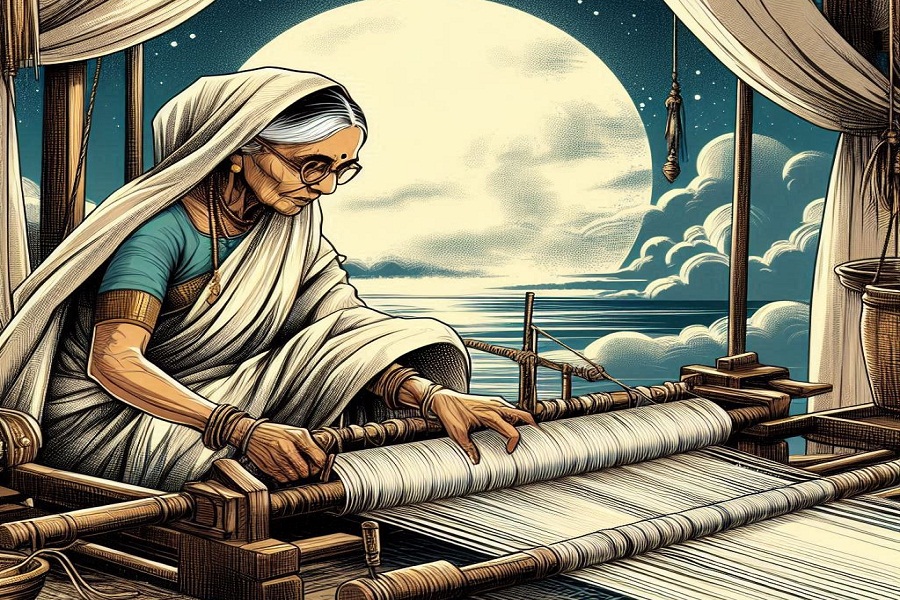
Published :
Updated :

Before the astronomical discoveries, people romanticized the Moon for its mysteriously bejewelled shimmer according to their imaginations. This practice used to be very common among many cultures. The Moon symbolizes love, passion, healing, emotion, intuition, kindness, memories, secrecy, femininity, fertility and the rhythm of time. Mythologies from many sources are heavily influenced by the idea of a goddess that heals the earth with her love appearing every night. She is a moon goddess. A revered figure who has been in folklore, holy scriptures, and legends since men learnt to dream.
Walk through the Indian subcontinent.
If you look at our subcontinent, the Moon is tied to folktales and myths. Mothers put their babies to sleep with the bedtime story of Chander Buri, an old lady who lives on the Moon and hand looms silver yarn with cotton clouds. It is a tale as old as time in Bengali households.
Rākā is the moon goddess associated with the full Moon and the ceremonies of installation and consecration. Dressed in rouge with a swan, she is associated with flute and tune.
Anumati is a lunar goddess signifying spirituality, peace, calm, motherlike, and permissive nature.
In the Pacific East, Changxi is the Chinese lunar deity and bore twelve unique moon daughters that would complete an entire journey across the heavens, which indicates twelve months of rotation for a year.
Do you want to know the mythical origin of the lunar eclipse?
Dewi Ratih is the moon goddess worshipped in Indonesia. Because she rejected a love offering from a giant named Kala Rau, he attacked Vishnuloka (the heaven) disguised as a devoted demon, Kuwera. Due to Ratih's warning, Vishnu beheaded Kala Rau without knowing he had consumed the tirta amerta, a drink of gods to be immortal. But only his throat touched the Tirta America, so Kala Rau only lived with his floating head. Now, Kala Rau would chase the Goddess and try to swallow Dewi Ratih. But because he does not have his whole body, Dewi Ratih would soon emerge from his neck. This is how the lunar eclipses originated.
Symbol of femininity
Neopagans worship the 'Triple Goddess': the Maiden, the Mother, and the Crone. Neopagans believe that with sexuality, pregnancy, breastfeeding, and ageing, women embody the Goddess and make the physical body sacred.
The Maiden represents enchantment, inception, expansion, the promise of new beginnings, birth, youth and youthful enthusiasm- epitomized by the waxing Moon.
The Mother represents ripeness, fertility, sexuality, fulfilment, stability, power and life- symbolized by the full Moon;
The Crone represents wisdom, repose, death, and endings- represented by the waning Moon.
Symbol of Love
Selene was the Greek personification of the Moon. Romans called her Luna.
The Goddess Selene had many lovers, but the most notable one was Endymion, a mortal. Endymion was an ethereally beautiful man, and Selene fell passionately in love with him while sleeping.
Enchanted by his beauty, Selene asked Zeus, the king of the Greek gods, to grant Endymion eternal life. Ironically, Zeus agrees to keep Endymion young but makes him sleep for eternity.
In some stories, Zeus awakened Endymion and asked him to choose between being young and asleep forever and old and awakened forever. The young man, in love with Selene, decided to sleep forever beneath her soft light. They had fifty children, identified with the fifty lunar months of the Olympiad, four years marking the beginning of the Olympic Games in ancient Greece.
Teaching life morals
Mayan parents taught their children an important life lesson through the following story. The Mayan Moon goddess' Ix Chel' fell victim to her husband, Kinich Ahau's insecurity, jealousy and wrath.
To get away from him, Ix Chel made a new home with the king of the vultures, who is much kinder. This made the sun god distraught and furious, so he went to Ix Chel, apologized, cried, and begged her to return home.
Being the forgiving deity Ix Chel was, she believed Kinich Ahau and went back. But Kinich Ahau soon began to show his true nature again. He struck her, scarring her face and dimming her bright rays.
From then on, she flew off to the dark, befriended stars and vowed to appear only at night. This indicates never to return to your abusers ever again- advice applicable to this date.


 For all latest news, follow The Financial Express Google News channel.
For all latest news, follow The Financial Express Google News channel.